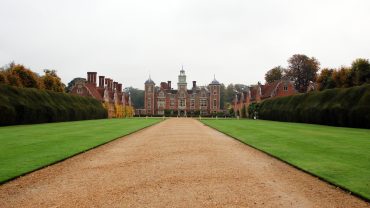From soot-stained mills to gravity-defying viaducts, Britain’s industrial architecture isn’t just bricks and mortar – it’s the steel-bolted backbone of the modern nation. These bold buildings didn’t just change their local areas, they sparked revolutions, powered empires, and gave us some seriously photogenic chimneys. So grab your hard hat (or at least a decent cuppa) as we dig into the iconic structures that made Britain the workshop of the world.
For much of its history, Britain’s landscape was shaped by rural life. Before 1700, the nation was mostly agricultural, with the most important industrial activities carried out by individual craftspeople working in domestic workshops or as part of networks of rural makers. Collectively known as the cottage industry, these artisans produced handcrafted goods for local markets, letting families combine farming with manufacturing. Yet, as demand for goods grew and technology advanced, so did the need for new buildings and new architectural design – and industrial style architecture in the UK soon began to dot the landscape.
In this article, we’re going to look at the history of industrial architecture in Britain, as well as some of the most famous British industrial buildings. Steel yourself as we hammer out the details of Britain’s icons of Industrial Revolution architecture.
The History of Industrial Architecture in Britain

Thaxted Windmill in Essex, built in 1804 (Credit: timothy_coleman via Getty Images)
The earliest industrial style architecture in the UK began as small, purpose-built buildings which evolved from domestic workshops. Alongside these were windmills and watermills – technology dating back to the Middle Ages – originally used to grind grain and carry out other basic tasks.
As the first Industrial Revolution dawned in the early to mid-eighteenth century, steam power, textile machinery, and iron founding transformed industry. At the same time, watermills became more sophisticated, harnessing new engineering techniques to drive machinery for flour milling, paper production, timber sawing, oilseed crushing, and even silk processing. Windmills continued to dot the countryside, their familiar silhouettes a reminder of centuries-old rural industry. Built of timber, stone, or brick, these humble structures laid the groundwork for the British industrial buildings, the large factories and mills, that would soon redefine the landscape.
Industrial Revolution Architecture

Quarry Bank Mill in Cheshire (Credit: onfilm via Getty Images)
The Second Industrial Revolution unfolded in the nineteenth century, bringing mass production, electrification, chemical manufacturing, and expanded rail and telegraph networks. This era marked a dramatic turning point for both Britain’s economy and its industrial architecture. Fuelled by technological innovation, abundant coal, and increasingly complex transport and communication systems, Britain rapidly transformed from a rural, craft-based society into the world’s first fully industrialised nation.
Huge factories, the likes of which had never been seen before in terms of size, scale and organisation, began to dominate Britain’s cities, and structures such as the Iron Bridge in Shropshire and the Quarry Bank textile mill near Manchester signalled a new era, where increasingly well-known British industrial buildings became symbols of progress and power.
The 1870s brought further changes as new materials including reinforced concrete and steel became widely available. These innovations allowed architects and engineers to experiment with new forms and styles, from the monumental chimneys of textile mills to the Art Deco flourishes of twentieth-century factory headquarters. The expansion of the road and railway network enabled the construction of vast warehouses, viaducts, and power stations, many of which remain among Britain’s most celebrated examples of industrial architecture. Among these iconic structures many have not only stood the test of time but also become widely renowned, here’s our selection of the most famous British industrial buildings.
Piece Hall, Halifax

Piece Hall, Halifax (Credit: Fraz Ahmed via Getty Images)
Opened in 1779 at a cost of £12,000, the Piece Hall in the West Yorkshire town of Halifax is a remarkable Grade I listed building believed to be the only surviving complete cloth hall in the UK. It was designed to bring merchants and buyers together with 315 rooms for the trading of “pieces” of handwoven woollen cloth, each thirty yards (27.4 metres) long. The architect of one of the great examples of industrial architecture in Britain is uncertain, though Thomas Bradley is often credited.
As the Industrial Revolution shifted trade to larger mills, the hall’s role declined, and it was repurposed as a wholesale market for meat, fish, and vegetables from the late nineteenth century until the 1970s. Saved from demolition by just one vote, it underwent a £19 million restoration and reopened in 2017 as a vibrant retail and events venue, with its grand courtyard now hosting exhibitions, performances, and community gatherings.
Bristol Temple Meads Railway Station, Bristol

Bristol Temple Meads Railway Station, Bristol (Credit: Leonid Andronov via Getty Images)
A staggering feat of Industrial Revolution architecture, Bristol Temple Meads Railway Station opened in 1840 and is a landmark of British railway history. Designed by Isambard Kingdom Brunel as the western terminus of the Great Western Railway’s main line from London, its original ‘mock Tudor’ building featured a dramatic wooden hammer beam roof inspired by Westminster Hall.
As traffic soared, the station was expanded several times, including a Jacobean-style extension for the Bristol & Exeter Railway which opened in 1854, and a major Gothic-style rebuild by Matthew Digby Wyatt began in 1871, with further enlargements by Percy Emerson Culverhouse in the 1930s. The station’s name comes from the Knights Templar, who owned the land in the twelfth and thirteenth centuries, and today, Temple Meads is a bustling transport hub with thirteen platforms. It is Grade I listed for its architectural and historical significance.
Iron Bridge, Shropshire

Iron Bridge, Shropshire (Credit: Gail Johnson via Getty Images)
Perhaps the most iconic example of industrial architecture in Britain, the world-famous Iron Bridge in Shropshire was completed in 1779 and opened to traffic in 1781. This iconic structure is celebrated as the world’s first major bridge made entirely of cast iron. Spanning just over thirty metres across the River Severn, it was designed by architect Thomas Farnolls Pritchard and built from nearly 1,700 individually cast iron components.
The bridge used 378 tons of iron – a radical innovation that demonstrated the structural potential of the material and inspired future engineering projects. Originally serving to connect the industrial town of Broseley with the mining town of Madeley, the bridge quickly became a symbol of Industrial Revolution architecture. Interestingly, each iron component was custom-cast, resulting in subtle differences throughout the structure.
Cromford Mills, Derbyshire

Cromford Mills, Derbyshire (Credit: Photos by R A Kearton via Getty Images)
Cromford Mills, built by Sir Richard Arkwright in 1771, is renowned as the world’s first successful water-powered cotton spinning mill and a cornerstone of the Industrial Revolution. Within twenty years, the complex – one of the most well-known examples of industrial style architecture in the UK – had expanded to include linked mills, warehouses, and workshops, all constructed from gritstone and brick, with security-focused designs such as minimal ground-floor windows.
However after water supply issues limited textile production by the 1840s, the site was repurposed for uses including a brewery and a cheese warehouse, and, from 1922, a factory producing pigments for paints and dyes. Historic England declared Cromford Mills ‘one of the country’s 100 irreplaceable sites’ and today it’s part of the Derwent Valley Mills UNESCO World Heritage Site.
Templeton Carpet Factory, Glasgow

Templeton Carpet Factory, Glasgow (Credit: theasis via Getty Images)
Templeton Carpet Factory, now known as Templeton On The Green, is one of Glasgow’s most striking industrial landmarks. Commissioned by James Templeton & Son for Axminster-style carpet manufacturing, it was designed by architect William Leiper in a flamboyant Venetian Gothic style inspired by the Doge’s Palace in Venice.
Construction began in 1888 and was completed four years later. Soon this icon of Scottish Industrial Revolution architecture became renowned for producing carpets for a prestigious clientele including ocean liners and Westminster Abbey. Templeton’s was also a pioneer in employee welfare, offering clubs, recreation grounds, and even a convalescent home for staff. Today, after a major renovation in 2005, it now houses apartments and offices, as well as a brewery, a bar, and a restaurant.
Ribblehead Viaduct, North Yorkshire

Ribblehead Viaduct, North Yorkshire (Credit: Sonja Ooms via Getty Images)
Ribblehead Viaduct is a monumental feat of Victorian engineering that carries the Settle – Carlisle railway across Batty Moss in North Yorkshire. Designed by John Sydney Crossley, the chief engineer of the Midland Railway, construction began in 1869 and was completed in 1874, with the line opening for passenger services in 1876. One of the most instantly recognisable examples of industrial architecture in Britain, the viaduct stretches approximately four hundred metres and features twenty-four stone arches each spanning almost fourteen metres.
Built by a workforce of up to 2,300 men – many of whom lived in temporary construction camps on adjacent land with names like Sebastopol and Belgravia – today the viaduct is a Grade II* listed structure, still in active rail use, and is one of the most dramatic landmarks in the Yorkshire landscape.
Anderton Boat Lift, Cheshire

Anderton Boat Lift, Cheshire (Credit: FatManPhotoUK via Getty Images)
The Anderton Boat Lift in Cheshire, completed in 1875, is a pioneering feat of Victorian engineering designed by Edwin Clark. Its purpose was to transfer boats and barges between the River Weaver and the Trent and Mersey Canal, overcoming a fifteen metre height difference. The lift operates using two enormous water-filled caissons that counterbalance each other, allowing vessels to be raised or lowered efficiently – a revolutionary solution at the time.
Originally hydraulic, the lift was converted to electric power in 1908. After more than a century of service, corrosion forced its closure in 1983, but a major restoration saw it reopen in 2002 as a working monument to Industrial Revolution architecture. Known as the ‘Cathedral of the Canals,’ it’s one of only two working boat lifts in Britain and is celebrated as one of the Seven Wonders of the Waterways.











